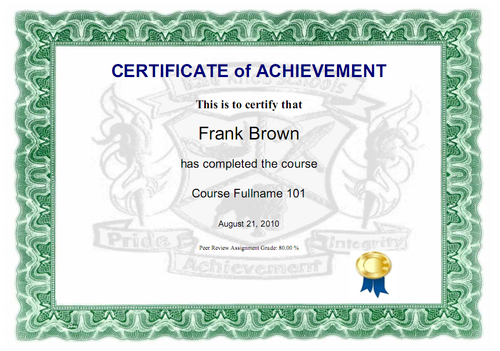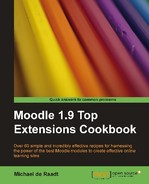|
Name |
Certificate |
|
Module type |
Activity module |
|
Author |
Chardelle Busch |
|
Released |
2007 |
|
Maintained |
Actively |
|
Languages |
English, Gallego, German, Italian, Portuguese Brazilian, Romanian, Spanish |
|
Compliance |
Good |
|
Documentation |
Online documentation, help files |
|
Errors |
None displayed |
Certificates for completing a course could be considered as a fun addition, or it could be quite a serious aspect. The certificate module allows students to generate certificates that they can keep electronically or print out. This module is highly configurable and can be linked to course grades or assessment outcomes.
Note
The Certificate module is one of the most downloaded contributed modules for Moodle. This is not surprising as the module is a great example of a well-designed and useful module. To see statistics about contributed module downloads, visit http://download.moodle.org/stats.php.
Unzip and copy the certificate directory into the /moodle/mod/ directory, then visit the Notifications page.
Once installed, you can add the Certificate module as an Activity by selecting Certificate from the Add an activity... menu.
Once created, you will be taken to the configuration page for a Certificate activity:
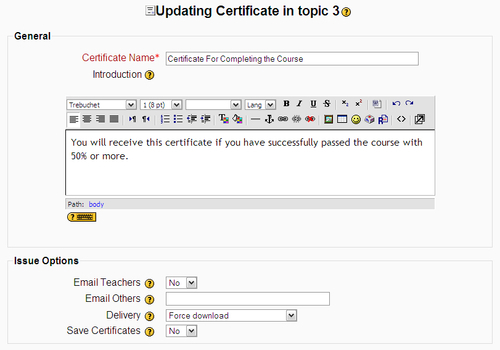
- The Certificate Name field becomes the link title on the course main page. The introduction appears on the page from which the certificate is downloaded. All students can reach the page that allows them to download a certificate, but only students who meet the set requirements will be able to download their certificate. If a student is ineligible they are told why, but successful students are not informed about why they have been successful. It may be wise to write what is required from students in the Introduction.
- In the second group of settings(Issue Options), there are settings related to how a certificate is issued to a student. The certificates are produced as PDF files, generated by the system. Teachers can be alerted when a certificate is produced by a student if the first setting, labeled Email Teachers, is set to Yes. Other people, such as a school principal can also be alerted, by typing their e-mail address into the field of the second setting. Multiple e-mail addresses can be added, separated by commas. The setting labeled Delivery allows you to control how the student receives the PDF file. You can allow the student to download the certificate when it is generated or the file can be e-mailed to the student. Students can always come back and re-issue a new certificate if needed. The final setting in this grouping controls the saving of certificate PDF files on the server. If certificates are saved, the teacher can view them using the Certificates Report (described later).
Scrolling down there are more options:
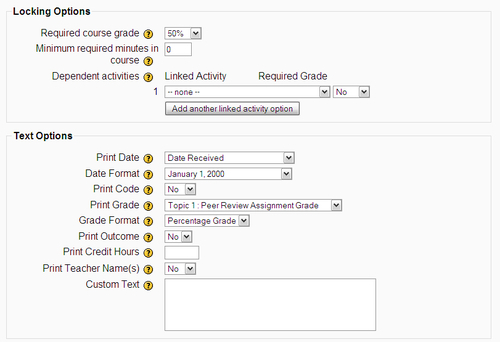
- The Locking Options specify the requirements a student must meet before they can be issued a certificate for completing the course. The requirements can be based around three factors: course grade, time spent online, and/or satisfactory completion of one or more assessment items (quizzes and assignments). Combinations of these can be created with all specified requirements needing to be met.
- The Text Options describe the information added to the certificate. The first setting labeled Print Date controls which date is added to the certificate. This setting has options for being no date, the date the certificate is produced, or the date of the end of the course (which must be set in the course settings). If a date is to be added to the certificate, one of the number of formats can be selected in the following setting.
- Each certificate has a code of ten random letters and numbers associated with it. If there is a possibility that certificates could be modified or forged by students, this code can be added to certificates and then later matched to issued certificates as a means of verification. The Print Code setting controls whether or not this code is printed on certificates.
- A grade value can optionally be added to the certificate. This can be the course grade or a single grade from one assessment item. The Print Grade setting controls this. Unfortunately, you cannot add multiple grade values to a certificate. The format of the grade can be set as being a raw mark, a percentage, or a grade value, as specified by the following setting.
Note
Letter Grades
Grade letter values are set at the site level. For information about setting letter grades, visit http://docs.moodle.org/en/Grade_letters.
- If outcomes have been specified in your course, these can be added to a certificate by changing the Print Outcome setting.
- A number of Credit Hours can be printed to the certificate. This might be useful if on completion of one course, a student is rewarded with a gift of credit that can be used towards another course or perhaps some form of free time in class.
Teacher names can be added to the certificate. The module uses the teachers defined for the course (users who have the teacher role). Additional teachers can be added by assigning them to the teacher role for the module instance. To do this, go to the settings for the Certificate activity and click the tab labeled Locally assigned roles. Click on the Teacher role and Add users from the list on the right to the one on the left.
- The final setting in the Text Options grouping allows you to specify additional Custom Text that can be printed to the certificate. This text does not override any other text shown on the certificate and does not appear with any great prominence. This might be useful for a small annotation on the certificate.
At the bottom of the Certificate configuration page there are some more settings:
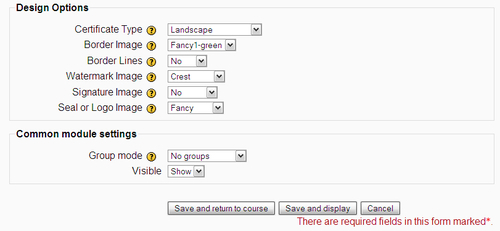
- The Design Options describe the appearance of the certificate page. The certificate can appear in Landscape or Portrait orientations in A4 or Letter format. If non-English characters are being used, the Unicode format should be selected.
- Borders can be added around the certificate, including a number of fancy borders and modern outlines. A watermark image can be added to the background, behind text in the certificate. A signature image can be added to the certificate. To add a new signature, create it as an image file (jpg or
png)and copy the file to/moodle/mod/certificate/pix/signatures/This signature is then available site-wide, which may not be appropriate in a large institution. A seal or logo image can be added to certificates. To add a new logo image, copy ajpgorpngimage to/moodle/mod/certificate/pix/seals/. This would be useful for institutional crests or logos.
With a Certificate activity in place, students can begin to produce their own certificates, provided requirements are met. When a teacher views the Certificate module page, there is a link in the top-right corner to a Certificates report.
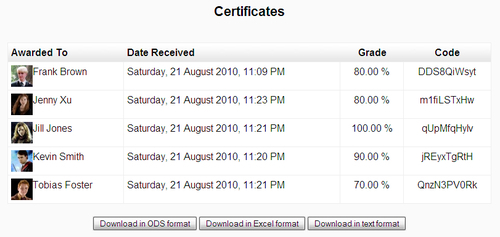
The Certificates report lists who has been awarded with a certificate, when it was awarded, and what grade was added to the certificate. The code for each certificate is provided and can be matched to a certificate for verification.
From a student's perspective, when they click on the link to the Certificate page they will see whether or not they are eligible to receive a certificate:

If students are eligible they will see the button above and be able to produce their certificate. If they are ineligible, the student is told that their grade is below the required level and no option to produce a certificate is provided.
The certificate is produced as a PDF file, whether it is to be delivered as a web download or using e-mail. The certificate is a somewhat official looking document that the student can keep as a record of their completion of the course.
